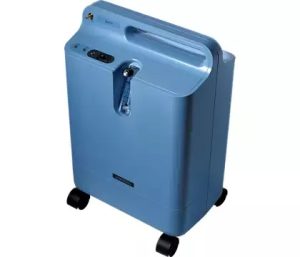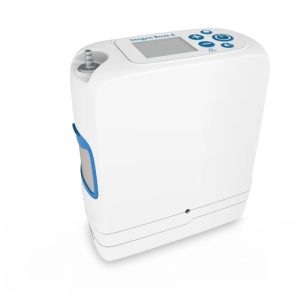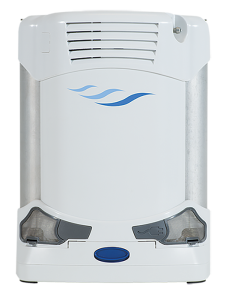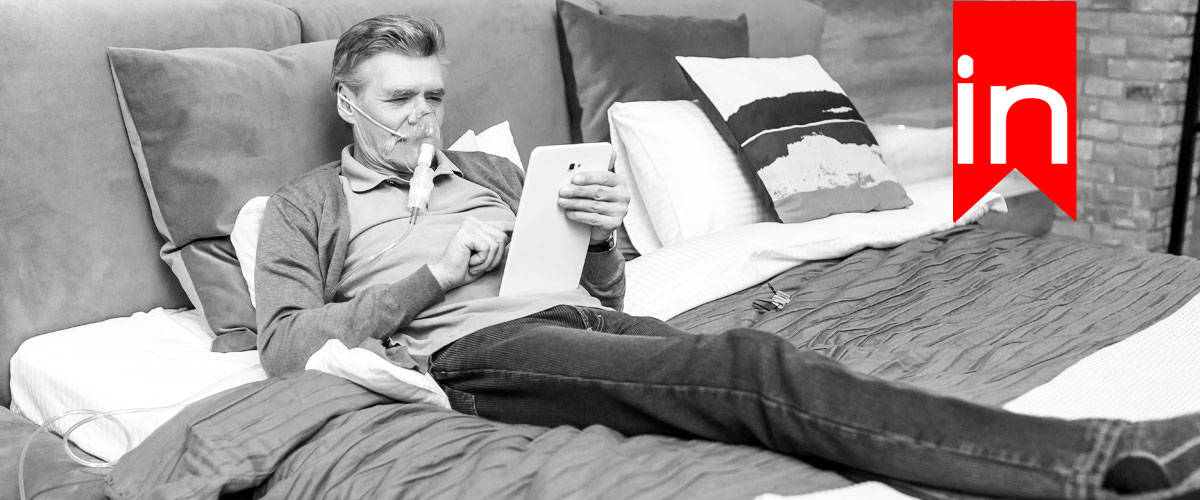An oxygen concentrator is a medical device that is used to give you extra oxygen. If you have a health condition, it may be prescribed by a doctor. Common health conditions that can require the support of oxygen concentrators would be:
- asthma
- the flu
- lung cancer
- COPD
- COVID-19
There are stationary and portable oxygen concentrators.
In this article, we will discuss the differences between stationary and portable oxygen concentrators, a few top brands, and we will also talk about CPAP masks, which a lot of people consider similar to an oxygen concentrator. We will find out whether they really are similar, and if so, how similar they are to each other.
How Does An Oxygen Concentrator Work?
Oxygen concentrators create pure oxygen by taking it from the surrounding air. The purity of the air that is provided by the concentrator is between 87 % – 93% of pure oxygen. In oxygen concentrators, these are delivered in two ways: either through a continuous flow (where air is provided in a continuous stream manner), or in small and measured amounts (this is called a pulse flow).
Some top brands of oxygen concentrators include:
- Philips
- Inogen
- CAIRE Inc.
Philips Oxygen Concentrators
Philips offers an oxygen concentrator called Everflo Oxygen System. It allows for home oxygen therapy. They also have a portable oxygen concentrator called the Respironics SimplyGo portable oxygen concentrator.

Inogen Oxygen Concentrators
Inogen also offers both portable oxygen concentrators and home oxygen therapy. Their Oxygen Concentrators are named as Inogen One G4, Inogen® Rove 6™, Inogen At Home®.

CAIRE Inc. Oxygen Concentrators
CAIRE Inc. offers portable oxygen concentrators and oxygen therapy systems at home. Some examples of Caire portable oxygen concentrators are CAIRE Freestyle Comfort, and CAIRE Eclipse 5. CAIRE Inc. is an oxygen concentrator supplier to hospitals, the military, and other commercial areas. CAIRE Inc. also offers nitrogen generators.

Home Vs. Portable Oxygen Concentrator
A portable oxygen concentrator provides oxygen therapy on the go, while a home system would limit the oxygen therapy to one location. Since the portable oxygen concentrator is used on the go, these are usually much lighter, while the at-home options are heavier.
An oxygen concentrator can really help with an active lifestyle by providing the required oxygen treatment one would need.
Do You Need A Prescription For Oxygen Concentrator In Canada?
An Oxygen Concentrator is prescription only, and not everyone can get one, just for the sake of trying to get more oxygen. For example, an athlete cannot just go to the store and buy one just to increase their oxygen capacity.
Coverage For Oxygen Concentratiors
The coverage for oxygen concentrators under public healthcare plans can vary by province and territory, as each region administers its own health services, including the provision of medical equipment like oxygen concentrators. Some examples include:
- Ontario: The Assistive Devices Program (ADP) covers 75% of the cost of an oxygen concentrator if you meet the medical criteria.
- British Columbia: Through the BC Pharmacare program, coverage is provided depending on the patient’s income and specific medical needs.
- Alberta: Seniors and other eligible individuals may receive benefits through Alberta Aids to Daily Living (AADL).
Difference Between Oxygen Tanks And Oxygen Concentrators
Oxygen tanks are best suited for short-term or mobile use, especially in emergency situations where no power supply is available. They are straightforward and reliable but require regular refills and can be cumbersome to transport.
Oxygen concentrators, on the other hand, are ideal for continuous, daily use, especially at home. They offer the convenience of not needing refills and are adaptable to varying breathing needs with features like pulse dose settings. However, they require power to operate, which can be a limitation in areas with frequent power outages unless a battery backup is available.
| Feature | Oxygen Tank | Oxygen Concentrator |
|---|
| Basic Description | Contains a fixed amount of pressurized oxygen. | Extracts oxygen from the air and delivers it at a continuous flow. |
| Portability | Portable models available, but can be bulky and heavy. | Portable models available, lighter and easier to carry around. |
| Oxygen Supply | Limited supply, requires refills. | Unlimited supply as long as the device is powered. |
| Operation | Does not require power to operate. | Requires power (battery or AC power). |
| Cost-Effectiveness | Less expensive initially, but refill costs can add up. | More expensive initially, but minimal running costs. |
| Maintenance | Minimal maintenance required; primarily needs refills. | Regular maintenance required (e.g., filter changes). |
| Noise | No noise during operation. | Generates noise during operation, although newer models are quieter. |
| Ease of Use | Simple to use once set up. | Requires setup and some operational knowledge. |
| Lifespan | High durability, long lifespan if maintained properly. | Generally requires more frequent replacement or servicing. |
| Availability of Flow | Continuous flow, adjustable based on the regulator settings. | Options for continuous flow or pulse dose, depending on the model. |
| Emergency Readiness | Excellent for emergencies as no power is needed. | Not ideal for power outages unless equipped with a backup battery. |
| Weight | Tanks are heavier, which can be a challenge for mobility. | Concentrators are generally lighter than tanks. |
| Healthcare Integration | Common in medical settings for acute use. | Increasingly preferred in home settings for chronic conditions. |
What Are CPAP Masks?
Furthermore, there is also the option of CPAP masks. CPAP stands for Continuous Positive Airway Pressure. CPAP Masks are helpful for those who suffer from sleep apnea. Those with sleep apnea struggle to get air and often wake up in the middle of the night. It can also be a danger to their life since their breath is obstructed. These masks are specifically used to give oxygen therapy to those who suffer from this condition.
Difference Between Oxygen Concentrators And CPAP Masks
An oxygen concentrator works similarly to a CPAP mask, but it is a lot more elaborately designed. A lot of COPD patients are actually paired with Oxygen Concentrators while asleep or awake, if the needs of the patient are more severe.
Oxygen Concentrators and CPAP Masks, which are both used for respiratory support but function in fundamentally different ways and serve different medical needs.
CPAP Masks: CPAP (Continuous Positive Airway Pressure) machines are used primarily by patients with obstructive sleep apnea to maintain airway openness. They work by providing a constant stream of air through a mask to bolster the airways open during sleep, thus preventing the characteristic interruptions in breathing associated with the condition.
| Feature | Oxygen Concentrator | CPAP Mask |
|---|
| Primary Use | To provide supplemental oxygen for people with respiratory disorders. | To keep airways open for people with sleep apnea during sleep. |
| Function | Extracts oxygen from the surrounding air and delivers it to the user. | Delivers air at pressure to prevent the collapse of airways. |
| Oxygen Delivery | Delivers a high concentration of oxygen directly to the patient. | Does not increase oxygen concentration, only airway pressure. |
| Method of Assistance | Helps by increasing the oxygen saturation in the blood. | Helps by providing a steady airflow that keeps airways open. |
| Components | Comprises a compressor, sieve bed filter, and nasal cannula or mask. | Consists of a mask, hose, and a motor that provides pressurized air. |
| Power Supply | Requires electrical power to operate. | Requires electrical power to operate. |
| Portability | Portable and stationary models available. | Primarily used at home, but travel-friendly models are available. |
| Noise Level | Generates noise during operation; newer models are quieter. | Relatively quiet, with some noise from the motor. |
| Cost | More expensive upfront, minimal operational costs. | Varied pricing; some models are pricey, but overall less expensive than long-term oxygen concentrator use. |
| Maintenance | Needs regular maintenance such as filter changes. | Requires regular cleaning of the mask and hose; filters should be replaced as per manufacturer guidelines. |
| Ease of Use | Simple operation once set up; may require adjustments for flow rate. | Needs adjustment for fit and comfort; pressure settings must be calibrated by a professional. |
| Healthcare Integration | Commonly used for chronic respiratory conditions and long-term care. | Primarily used for treating sleep apnea. |
| Emergency Readiness | Not suitable for emergencies where power is not available. | Not applicable in emergency use; designed for chronic management of sleep apnea. |
Choosing between an oxygen concentrator and a CPAP mask depends significantly on the medical condition being treated. Oxygen concentrators are not substitutes for CPAP machines, as they serve entirely different functional purposes in patient care.
Senior’s Respiratory Care
Oxygen concentrators are invaluable devices for seniors who suffer from respiratory issues that reduce blood oxygen levels, such as COPD, emphysema, or pulmonary fibrosis. Unlike traditional oxygen tanks that provide a fixed amount of oxygen, concentrators filter and process room air to deliver air that is enriched with oxygen, providing an ongoing supply.
These devices are particularly suited for continuous home use, being more cost-effective and safer over the long term compared to oxygen tanks that require frequent refilling. Modern oxygen concentrators are designed to be user-friendly and require minimal maintenance, typically just regular cleaning and occasional filter replacement.
For seniors, the benefits of using an oxygen concentrator include improved ability to engage in activities of daily living, better physical stamina, and enhanced overall quality of life. Oxygen therapy can alleviate symptoms of breathlessness and fatigue, thus significantly improving sleep and mood.
Portable oxygen concentrators (POCs) offer mobility to those who are active and wish to leave the house; these devices are lightweight and often come with a carrying bag or a cart, and they can operate on battery power. This feature allows seniors to maintain their independence and mobility without compromising their oxygen therapy needs.
Safety features on these devices include alarms for low oxygen levels, power failure, and technical malfunctions, ensuring that users are immediately aware of any issues. Oxygen concentrators are a critical, life-enhancing tool for seniors with chronic pulmonary conditions, providing vital respiratory support in a convenient and efficient manner.





